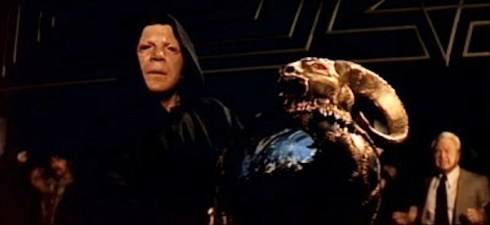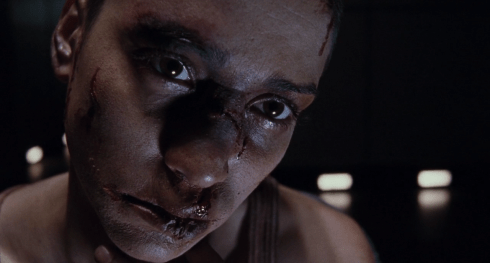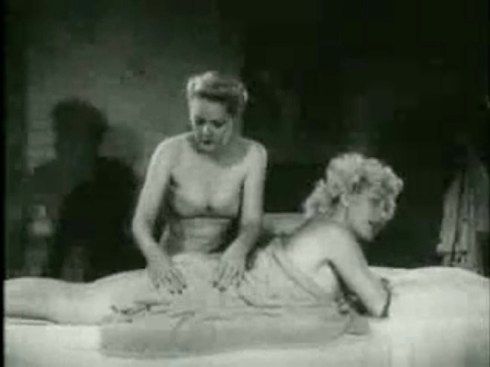


David Niven is the Marquis Philippe de Montfaucon who is called back to his castle Bellenac because the dry season is destroying his vineyards. He reluctantly lets his wife (Deborah Kerr) and children join him. de Montfaucon has a superstitious secret, as the people surrounding him hold pagan rituals, for his legacy is connected to a great sacrifice…also stars Sharon Tate, Donald Pleasance, and David Hemmings. Directed by J. Lee Thompson.


A 19th Century New Hampshire farmer who makes a compact with the Devil for economic success enlists Daniel Webster to extract him from his contract. Stars Edward Arnold, Walter Houston as you know who, and Jane Darwell. Directed by William Dieterle

An old man sells his soul to the devil and turns into a young man. He then uses witchcraft and black magic to win a woman from his rival. Stars Ed Nelson, Edgar Buchanan, Jean Allison, and Richard Crane.


A man is haunted by visions of a beautiful woman. When he finally meets her, he winds up involved in a satanic cult. Stars Robert Alda and Linda Christian.


Roland Brissot bought a nickel a talisman that gives him love, fame, and wealth. The talisman is a cut left hand..directed by Maurice Tourneur

Sylvia Walton returns from Harlem to take over a Jamaican plantation from her vindictive half-sister, amid the growing sound of drums. Stars Nina Mae McKinney, Jack Carter, and Ida James.

A young girl whose mother had sold her soul to Satan when she was born is told by Satan that she must marry a fellow demon. Directed by Jeannot Szwarc and starring Shelley Winters and Belinda Montgomery. The 70s made for tv movie!


Two couples vacationing together in an R.V. from Texas to Colorado are terrorized after they witness a murder during a Satanic ritual. Starring Peter Fonda, Warren Oates, Loretta Swit, Lara Parker, and R.G. Armstrong.


A bunch of Satanists in the American rural landscape have terrible powers which enable them to melt their victims. However one of the children of an earlier victim vows to destroy them. Stars Ernest Borgnine, Ida Lupino, William Shatner and Eddie Albert. Directed by Robert Fuest.


Lady Dracula uses Dracula’s ring to lure beautiful girls to her castle, where she murders them so she can bathe in their blood. Starring Mark Damon and Rosalba Neri.


Christopher Lee is Nicholas the Duc de Richleau who travels to England to visit a friend and discovers a satanic cult! Also stars Charles Gray and is directed by Terence Fisher.

An American occult novelist battles to save the soul of a young girl from a group of Satanists, led by an excommunicated priest, who plans on using her as the representative of the Devil on Earth. Stars Christopher Lee, Richard Widmark, Honor Blackman, Denholm Elliot and Nastassja Kinski.


A notorious outlaw being escorted to prison by a homesteader and his wife turns out to have satanic powers. He uses them on the man’s wife to try to possess her and help him escape. ABC movie of the week starring Janice Rule and Gene Barry.

Grave robbers supply a doctor with bodies. Based on Burke and Hare. Directed by Freddie Francis and starred Timothy Dalton, Jonathan Pryce, Julian Sands, and Twiggy.

a 12-year-old whose father has died in the Spanish Civil War arrives at an ominous boy’s orphanage he discovers the school is haunted and has many dark secrets that he must uncover. Guillermo del Toro’s hauntingly beautiful film.


A woman on the run from her abusive husband encounters a mysterious hitchhiker. Stars Robert John Burke, Chelsea Field, and Zakes Mokae.


An escaped Devil’s Island convict uses miniaturized humans to wreak vengeance on those that framed him. Story by Tod Browning and uncredited for his directing it stars Lionel Barrymore as Paul Lavond/Madame Mandilip, and Maureen O’Sullivan as the daughter he is cheated of.

Cynthia Kyle murders her parents while having sex. Eights years later she is plagued with nightmares! Directed by Ray Dennis Steckler


An evil hypnotist/ventriloquist plots to gain an heiress’ millions.Â

A dog that is a minion of Satan terrorizes a suburban family. Oh well, not one of Curtis Harrington’s shining moments. Stars Richard Crenna Yvette Mimieux and Kim Richards. Another ABC Movie of the Week from the 70s!


Following a horrifying experience with the occult in Africa, a schoolteacher moves to a small English village, only to discover that black magic resides there as well. Stars Joan Fontaine, Kay Walsh, and Alec McCowen.


When Max dies in an accident, he winds up in hell. But the devil Barney makes him an offer: if he can get three innocent youths to sell him their souls, Max can go back to earth. Stars Bill Cosby as Barney Satin and Elliot Gould as Max Devlin.

A GORGEOUS DEMON! They created an inhuman being who destroyed everything she touched! The woman they couldn’t kill! Directed by Kurt Neumann and starring Mari Blanchard and Albert Dekker.


Two brothers, both of whom are warlocks, use their powers and the covens of witches to battle over the family fortune. Stars Lon Chaney Jr., John Carradine, and Andrea King.

A secret vampire cult, which has its headquarters beneath the town cemetery, searches for victims for its human sacrifice rituals. Stars William Sylvester and Carole Gray. Directed by Lance Comfort.

The patriarch of a wealthy family fears that he will show up one day in vampire form. Should this happen, he warns his family not to let him back in his house, no matter how much he begs them. Stars Giani Garko and Agostina Belli.

An evil ruler uses witchcraft and evil spirits to keep his subjects in line, but his reign of terror prompts the people to revolt. Stars Paul Naschy and Norma Sebre

An all-female motorcycle gang, called ‘The Maneaters’ holds motorcycle races, as well as terrorize the residents of a small Florida town, and clashes off against an all-male rival gang of hot-riders. Directed by Herschell Gordon Lewis.

In 17th-century France, Father Urbain Grandier seeks to protect the city of Loudun from the corrupt establishment of Cardinal Richelieu. Hysteria occurs within the city when he is accused of witchcraft by a sexually repressed nun. Ken Russell’s vigorous take on the true story of The Devils of Loudun. Starring Vanessa Redgrave and Oliver Reed.

Euro-Exploitation thriller starring Carroll Baker, George Hilton, and Stephen Boyd. It’s got Carroll Baker nuf said!

Adult/Fantasy about Miss Justine Jones who is tired of her life and commits suicide. Will she end up in Heaven or Hell? Starring Georgina Spelvin as Justine Jones. Directed by Gerard Damiano.


Ti West directs this contemporary horror flick that looks like it was truly made In the 1980s. College student Samantha Hughes (Jocelyn Donahue)takes a strange babysitting job that coincides with a full lunar eclipse. She slowly realizes her clients Tom Noonan and Mary Woronov plan to use her in a satanic ritual.


In this feature version of the Swedish TV series “13 Demon Street,” a 50,000-year-old woman is found frozen in an ice field, and a man’s death is foretold in dreams. Narrated by Lon Chaney Jr.


Based on an ancient Scottish folk song, an older woman uses witchcraft to keep her young jet-set friends. Directed by Roddy McDowall starring the amazing Ava Gardner, Ian McShane, Stephanie Beacham, and Cyril Cusack.


The wife of a cruel headmaster and his mistress conspire to kill him, but after the murder is committed, his body disappears, and strange events begin to plague the two women. Henri-Georges Cluzot’s macabre masterpiece starring Simone Signoret, Vera Cluzot, and Paul Meurisse.


Elke Sommer is Lisa a tourist in an ancient city, who stumbles onto an old mansion and soon becomes the victim of a diabolical evil. Also starring Telly Savalas as Leandro a devil! and Alida Vali as the countess. Directed by the master of Gothic horror-Mario Bava.
The Devil made me do this post!-MonsterGirl !


















































































































































































































